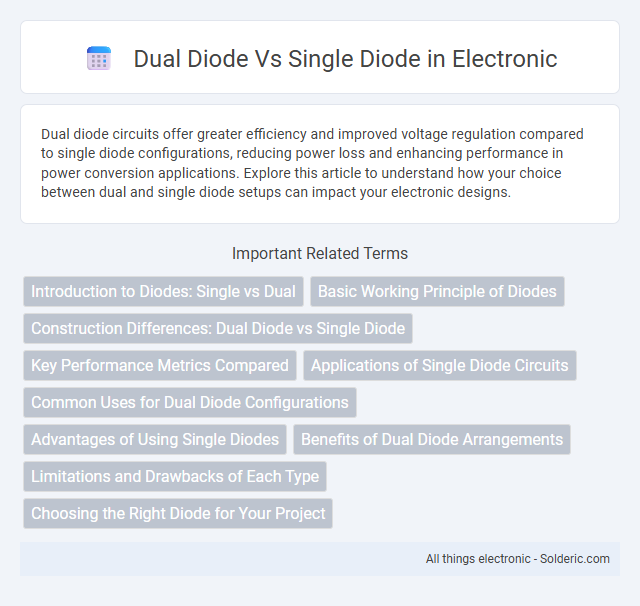Dual diode circuits offer greater efficiency and improved voltage regulation compared to single diode configurations, reducing power loss and enhancing performance in power conversion applications. Explore this article to understand how your choice between dual and single diode setups can impact your electronic designs.
Comparison Table
| Feature | Dual Diode | Single Diode |
|---|---|---|
| Structure | Two diodes in a single package | One diode per package |
| Function | Allows bidirectional current flow in some configurations | Allows unidirectional current flow |
| Applications | Voltage clamping, rectification, signal demodulation | Rectification, signal protection, switching |
| Size | Compact, saves PCB space | Larger PCB footprint if multiple diodes needed |
| Cost | Generally higher per unit but cost-effective for dual functions | Lower cost per diode |
| Complexity | Integrates two diodes, simplifies circuit design | Requires separate diodes for multiple functions |
Introduction to Diodes: Single vs Dual
Single diodes consist of one semiconductor junction allowing current flow in a single direction, commonly used for rectification and signal modulation. Dual diodes integrate two diodes in a single package, offering compactness and efficiency for applications like voltage regulation and RF circuits. Understanding the difference between single and dual diodes helps optimize your electronic designs for performance and space.
Basic Working Principle of Diodes
A single diode allows current to flow in one direction, effectively acting as a one-way valve for electrical signals. In contrast, a dual diode package contains two diodes within a single component, often configured to perform functions like rectification, voltage regulation, or signal mixing more efficiently. The basic working principle remains the same: controlling the direction of current flow based on the semiconductor's p-n junction properties, but dual diodes enable more complex circuit configurations in a compact form factor.
Construction Differences: Dual Diode vs Single Diode
Dual diodes consist of two diode structures integrated within a single package, enabling simultaneous or complementary current paths, whereas single diodes contain only one PN junction for unidirectional current flow. The dual diode's construction often features two anodes with a shared cathode or two cathodes with a shared anode, enhancing circuit simplification and space efficiency. Single diodes are simpler with one anode and one cathode, typically used in basic rectification or switching functions.
Key Performance Metrics Compared
Dual diodes typically offer higher current handling capabilities and improved thermal performance compared to single diodes, making them suitable for high-power applications. They achieve better reverse recovery times and reduced switching losses, enhancing efficiency in power conversion systems. Single diodes, while simpler and often cheaper, usually exhibit higher forward voltage drops and slower switching speeds, impacting overall circuit performance in demanding environments.
Applications of Single Diode Circuits
Single diode circuits are primarily used in rectification for converting AC to DC, signal demodulation in communication systems, and voltage regulation in power supplies. They also serve important roles in protection circuits, such as flyback diodes in inductive loads to prevent voltage spikes. Their simplicity and efficiency make them ideal for low-cost, low-power applications in consumer electronics and instrumentation.
Common Uses for Dual Diode Configurations
Dual diode configurations are commonly used in rectifier circuits, voltage regulation, and signal demodulation to enhance efficiency and reduce power loss. Their ability to handle bidirectional current flow makes them ideal for AC to DC conversion, protecting circuits from voltage spikes. Your choice of dual diode setups can improve performance and reliability in power supplies and electronic communication devices.
Advantages of Using Single Diodes
Single diodes offer advantages such as simpler circuit design, reduced component count, and lower cost compared to dual diodes. You benefit from easier troubleshooting and replacement, which enhances maintenance efficiency in electronic systems. Their compact size also suits applications with space constraints while providing reliable rectification and signal control.
Benefits of Dual Diode Arrangements
Dual diode arrangements provide enhanced efficiency by minimizing voltage drop and reducing power loss compared to single diode setups. Your circuit gains improved thermal management and reliability due to balanced current distribution across the diodes. This configuration is particularly beneficial in applications requiring higher current capacity and improved reverse voltage protection.
Limitations and Drawbacks of Each Type
Single diodes often face limitations such as higher power dissipation and reduced efficiency in circuits requiring voltage regulation or rectification under high current. Dual diodes can mitigate these issues by offering better thermal management and improved performance in dual-path circuits but may introduce complexity, increased cost, and potential space constraints on your PCB. Designers must weigh the trade-offs between single diode simplicity and dual diode advantages to optimize their specific electronic applications.
Choosing the Right Diode for Your Project
Selecting the right diode for your project requires understanding the distinct functions of dual diodes versus single diodes. Dual diodes combine two diode elements in one package, providing space-saving solutions and improved circuit efficiency, especially in applications like power rectification and voltage regulation. Your choice should consider factors such as current rating, voltage requirements, and circuit complexity to ensure optimal performance and reliability.
Dual diode vs single diode Infographic

 solderic.com
solderic.com